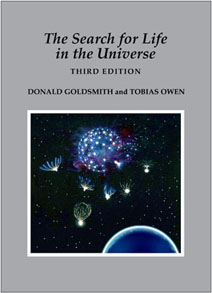
The Search for Life in the Universe, Third Edition
Long recognized as the "Gold Standard" text for astrobiology courses, The Search for Life in the Universe now appears in a completely revised and updated Third Edition. This book engages students in astronomy by presenting a great, unsolved mystery: How likely is life beyond earth, and how can we find it if it exists?
Summary
Long recognized as the “Gold Standard” text for astrobiology courses, The Search for Life in the Universe now appears in a completely revised and updated Third Edition. This book engages students in astronomy by presenting a great, unsolved mystery: How likely is life beyond earth, and how can we find it if it exists? The text covers the fundamentals of astronomy and astrophysics, including the discovery of more than 55 planets around other stars, and also provides an overview of biology, geology, evolution, and the possibilities of interstellar travel and communication. Written for readers with no background in mathematics, the book includes 24 color insert pages and brilliantly rendered illustrations by Jon Lomberg.
Resources
List of Adoptions
Front Matter
Preface
Foreword
Sample Chapter
Table of Contents
Preface
Foreword by Jill Tarter
Part One: Why Do We Search?
- Chapter 1 The Search from the Human Perspective
The Quest for Life’s Origins
The Importance of Mars
The Scientific View of the Universe
The Laws of Nature
Applying Scientific Thinking in Everyday Life
The Scientific Method in the Search for Extraterrestrial Life
Cosmic Loneliness
A Conservative Approach to the Search for Life
Summary
Key Terms
Questions
Further Reading
Part Two: The Universe
- Chapter 2 The Universe Small and Large
The Distances to Astronomical Objects
The Scale of the Solar System
Measuring Stellar Distances with the Parallax Effect
Estimating Distances with the Inverse-Square Brightness Law
The Spectra of Stars
Summary
Key Terms
Questions
Further Reading - Chapter 3 The Birthplaces of Stars
Probing the Spaces Between the Stars
Radio Waves from Interstellar Hydrogen Atoms
Interstellar Dust Grains
Interstellar Molecules
Molecular Clouds
The Different Types of Molecules in Molecular Clouds
Did Life Begin in Interstellar Clouds?
The Birth of Stars
How Many Stars Form with Planets?
Summary
Key Terms
Questions
Further Reading - Chapter 4 Energy Liberation in Stars
Types of Stars
The Temperature-Luminosity Diagram
Red Giants and White Dwarfs
Stellar Lifetimes
How Stars Liberate Energy
The Proton-Proton Cycle
The Important of Temperature Inside Stars
The Struggle Between Gravity and Pressure
The Influence of Mass on Stellar Lifetimes
Summary
Key Terms
Questions
Further Reading - Chapter 5 How Stars End Their Lives
Nuclear Fuel Consumption in Stars
The Evolution of Stars
The Red-Giant Phase
White Dwarfs
Could Civilizations Exist Around White Dwarfs?
Supernova Explosions
The Production of Heavy Elements in Supernovae
The Effects of Supernovae on Later Generations of Stars
Cosmic Rays
Black Holes
Pulsars: Cosmic Lighthouses?
Precise Pulsar Timing Reveals the Existence of Planets!
The Binary Pulsar and Gravity Radiation
Gamma-Ray Bursters: Mysterious Powerhouses of the Cosmos
Summary
Key Terms
Questions
Further Reading - Chapter 6 Galaxies and the Expanding Universe
Spiral Galaxies
Elliptical Galaxies
Irregular Galaxies
The Formation of Galaxies
Star Clusters
Radio Galaxies
The Doppler Shift and the Expanding Universe
The Big Bang
The Cosmic Background of Photons
The Hypothesis of the Inflationary Universe
Dark Matter on the Largest Scales of Distance
Is the Universe Finite or Infinite?
Will the Universe Expand Forever?
Quasars
Accretion Disks and Supermassive Black Holes
Could Quasars Be Intergalactic Beacons?
Summary
Key Terms
Questions
Further Reading
Part Three: Life
- Chapter 7 The Nature of Life on Earth
What Is Life?
Biologically Important Compounds
The Capacity to Reproduce
DNA Does More than Govern Reproduction
Evolution and the Arrow of Time
Energy
The Unity of Life
Summary
Key Terms
Questions
Further Reading - Chapter 8 The Origin of Life
How Earth Got Its Atmosphere
The Evolution of the Atmosphere
The Effects of Life on the Evolution of Earth’s Atmosphere
Early Ideas About the Origin of Life
The Chemical Evolution Model for the Origin of Life
An Experimental Test of the Primordial-Soup Model
Did Life Really Originate in This Manner?
An External Alternative
Polymerization
Is Our Starting Point Too Advanced?
Beyond Polymers
Summary
Key Terms
Questions
Further Reading - Chapter 9 From Molecules to Minds
Prokaryotes
Eukaryotes
The Great Leap Forward
Suitable Stars for Life
Life on Other Planets
Evolution and the Development of Intelligence
Is Intelligence Inevitable?
Future Evolution on Earth
The Web of Life
Summary
Key Terms
Questions
Further Reading - Chapter 10 How Strange Can Life Be?
The Chemistry of Alien Life
The Superiority of Carbon
Solvents
Nonchemical Life
Black Clouds
Life on Neutron Stars
Gravitational Life
The Advantages of Being Average
Summary
Key Terms
Questions
Further Reading
Part Four: The Search for Life in the Solar System
- Chapter 11 The Origin and Early History of the Solar System
The Formation of the Solar System
Comets
Asteroids, Meteoroids, and Meteorites
Bombardment of the Inner Planets: A Threat to Life?
Meteorites
Amino Acids in Meteorites
Mercury and the Moon
The Early History of the Earth and the Moon
Human Exploration of the Moon
Summary
Key Terms
Questions
Further Reading - Chapter 12 Venus
The Temperature and Rotation of Venus
The Atmosphere of Venus
The Greenhouse Effect
Why Is Venus So Different from Earth?
Life on Venus?
Exploration of Venus by Spacecraft
Summary
Key Terms
Questions
Further Reading - Chapter 13 Mars
Modern Observations of Mars
Results from Early Space Probes to Mars
The Viking Project
Mars After Viking
Further Missions to Mars
Phobos and Deimos
Summary
Key Terms
Questions
Further Reading - Chapter 14 Is There Life on Mars?
How to Find Martian Microorganisms
The Viking Results: Atmospheric Analysis
The Viking Results: Soil Analysis
The Viking Biology Experiments
Results of the Viking Biology Experiments
Did the Vikings Land in the Wrong Places?
An Ancient Eden? Goals for Future Exploration
Rocks from Mars! A Preview of Coming Attractions
What Went Wrong on Mars?
Epilogue: What About That Face on Mars?
Summary
Key Terms
Questions
Further Reading - Chapter 15 The Giant Planets and Their Satellites
Spacecraft to the Outer Solar System
The Composition of the Giant Planets
Chemistry on the Giant Planets
Could Life Exist on the Giant Planets?
Rings and Satellites
Titan
Iapetus: An Intelligence Test for Earthlings?
Triton: Chemistry at Low Temperatures
Cosmic Messengers
Summary
Key Terms
Questions
Further Reading
Part Five: The Search for Extraterrestrial Intelligence
- Chapter 16 Is Earth Unique?
Which Characteristics Distinguish Earth as an Abode of Life?
Avoiding Regions of Cosmic Violence
The Need for Heavy Elements
The Importance of Temperature
The Threat of Impacts
The Advantages of a Large Moon
A Conservative Approach: Defining the Habitable Zone Around a Star
Which Stars Offer Good Habitable Zones?
Can Multiple-Star Systems Provide Good Habitable Zones?
Discovering Extrasolar Planets: Six Promising Methods and One Highly Successful One
Summary
Key Terms
Questions
Further Reading - Chapter 17 The Discovery of Extrasolar Planets
The Great Success: Using the Doppler Effect to Discover Extrasolar Planets
What Does the Doppler-Shift Method Reveal About Extrasolar Planets?
The Doppler-Shift Technique Reveals New Worlds
Why Do So Many Extrasolar Planets Orbit Extremely Close to Their Stars?
The Importance of Jupiter’s Distance
The Mystery of Eccentricity
How Many Stars Have Planets with the Right Conditions for Life?
Alternative Possibilities for Habitable Planets
How Many Habitable Planets Exist in the Milky Way?
How Can We Discover Earthlike Planets Around Other Stars?
Summary
Key Terms
Questions
Further Reading - Chapter 18 Extraterrestrial Civilizations: How Many? How Distant?
How Many Civilizations Exist?
Estimating the Number of Civilizations by Using the Drake Equation
The Importance of Survival
How Eager are Civilizations for Contact?
How Widely Separated Are Civilizations in the Milky Way?
Further Advances of Intelligent Civilizations
Summary
Key Terms
Questions
Further Reading
- Chapter 19 Interstellar Spaceflight
Sending Information: Photons Versus Rockets
Interstellar Spaceships
Faster, Larger, More Expensive
When Time Slows Down
The Difficulties of High-Velocity Spaceflight
Automated Message Probes
Summary
Key Terms
Questions
Further Reading - Chapter 20 Interstellar Radio and Television Messages
Where Should We Look?
What Frequencies Should We Search?
What Frequency Bandwidth and Total Frequency Range to Examine?
How Can We Recognize Another Civilization?
The Present State of Radio Searches for other Civilizations
What Messages Could We Send or Expect to Receive?
A Crucial Difference: Beamed Signals versus Eavesdropping
Do SETI Searches Limit Themselves Too Severely by Relying on Radio Waves?
Summary
Key Terms
Questions
Further Reading - Chapter 21 Extraterrestrial Visitors to Earth?
What Evidence Do We Seek?
Four Representative UFO Sightings
Difficulties in Verifying the Spacecraft Hypothesis
Classification of UFO Reports
Arguments for the Spacecraft Hypothesis
Some Conclusions About UFOs
What About a Government Conspiracy?
Von Daniken: Charlatan of the Gods?
Summary
Key Terms
Questions
Further Reading - Chapter 22 Where Is Everybody?
We May Be Alone, or Nearly So
Advanced Civilizations May Have Little Interest in Communication
We Are Still a Primitive Civilization
Epilogue: The Search Continues
Further Reading - Appendix
- Glossary
- Index
Reviews
“Teachers and students everywhere of wildly popular courses on life in the universe should rejoice to see this update of the classic textbook by Don Goldsmith and Toby Owen.”
-Frank Shu, University of California at Berkeley
“Quite possibly the best astrobiology text available…[it is] clear, interesting and captivating. I highly recommend The Search for Life in the Universe to anyone with a serious interest in astrobiology.”
-International Journal of Astrobiology
“This textbook by Goldsmith and Owen will take you on a fascinating journey.”
-Jill Tarter, SETI Institute
“Certainly this text will increase the wonder and delight which all of us find in the search for life in the universe.”
-Frank Drake, from the Foreword to the Second Edition
“I teach astronomy with a search-for-life curriculum because that approach, which emphasizes the connections among astronomy, geology, biology, and planetary science, engages students much more effectively than the standard “tour-the-universe” class does. Goldsmith and Owen’s new edition of The Search for Life thoroughly updates an already excellent text, making it the ideal book for this course.”
-Dana Backman, Franklin & Marshall College
“When these authors came out with their first edition in 1980, I adopted it happily and have used it ever since. The third edition is very welcome in a field that is developing very rapidly. I am especially pleased with the new illustrations by Jon Lomberg, which help students gain perspective on difficult concepts.”
-Bob Garrison, University of Toronto
“The third edition of The Search for Life in the Universe by Goldsmith and Owen is a welcome and timely update of what has become a classic text. Its accessible yet thorough presentation makes this book an easy choice.”
-Karen B. Kwitter, Williams College
“The Search for Life in the Universe is a worthy successor to Shklovskii and Sagan’s wonderful work of 35 years ago, updating both the astronomical and the biological aspects of the subject that has recently come to be called astrobiology. Supplemented by some reading in a more traditional introductory book, I use The Search for Life in the Universe as the principal text in an introductory course on the solar system.”
-William Irvine, University of Massachusetts, Amherst
“This newly revised edition, replete with much current and updated information, weaves together with wit and enthusiasm, the diverse and fascinating cosmological, astronomical, physical, chemical, biological, sociological and philosophical concerns underlying the great query: is there life in the universe?”
-Alan M. Rosan, Drew University
“Adopting the text of Goldsmith and Owen for the ET Life class at Sonoma State University was an intellectual evolutionary step — out of popular speculation and into a rigorous and enjoyable astrobiology education.”
-Scott Funkhouser, UC Berkeley, Sonoma State University


